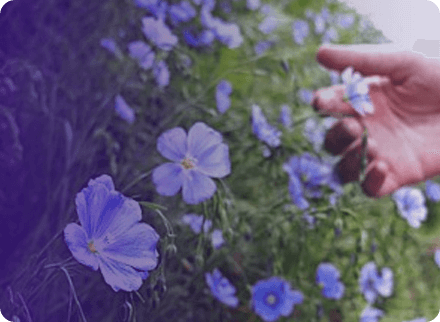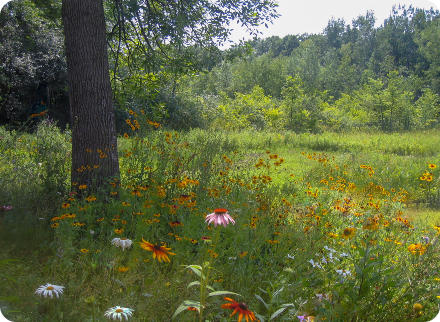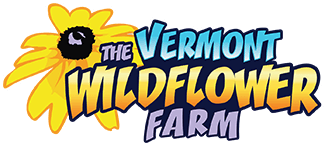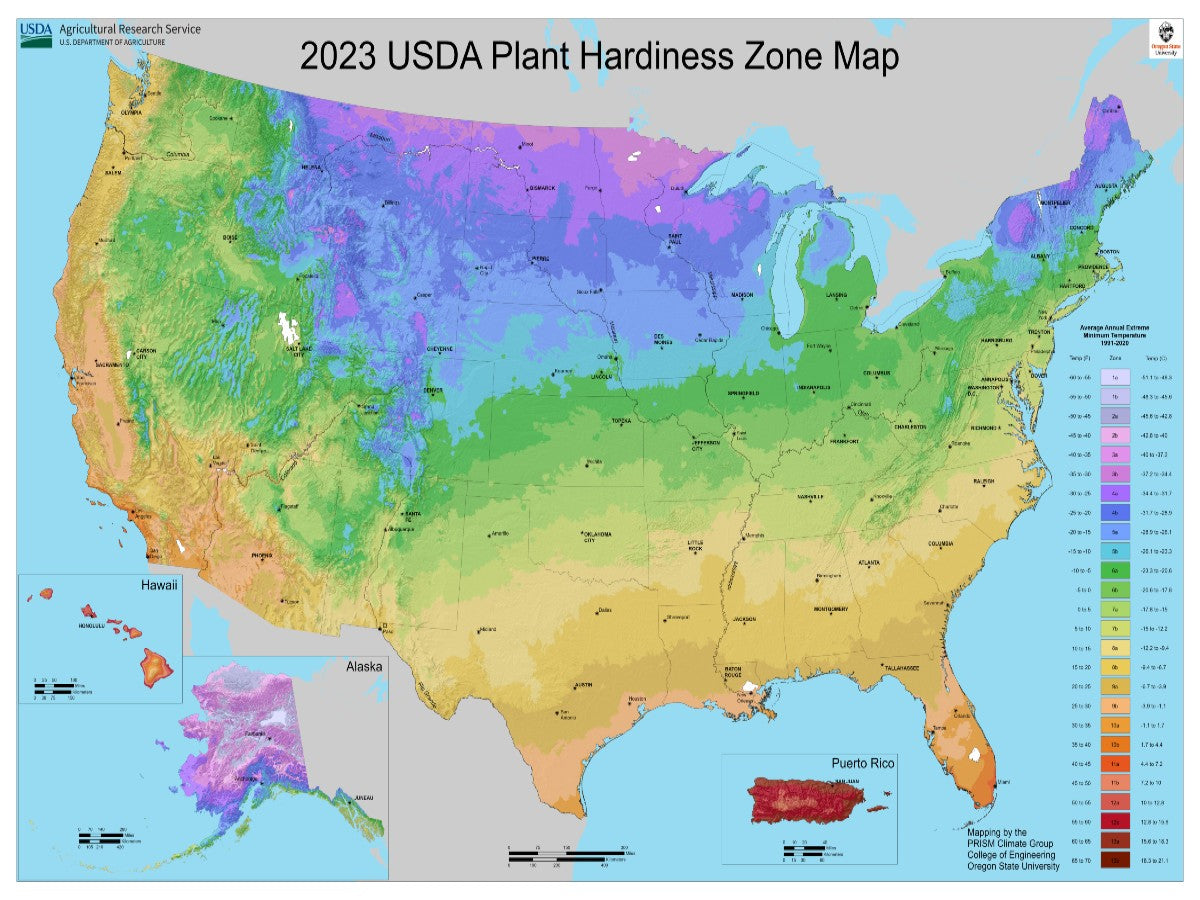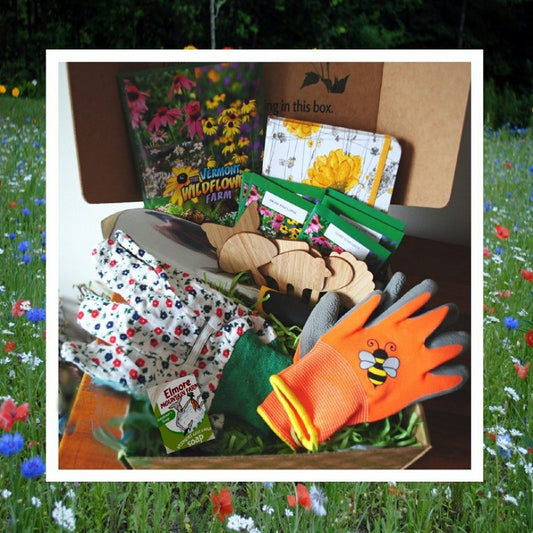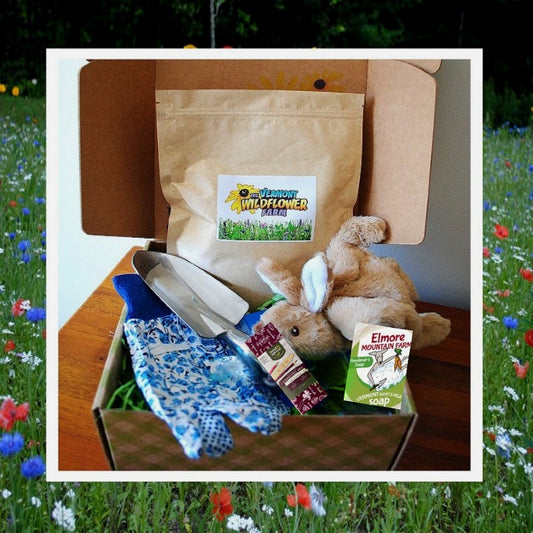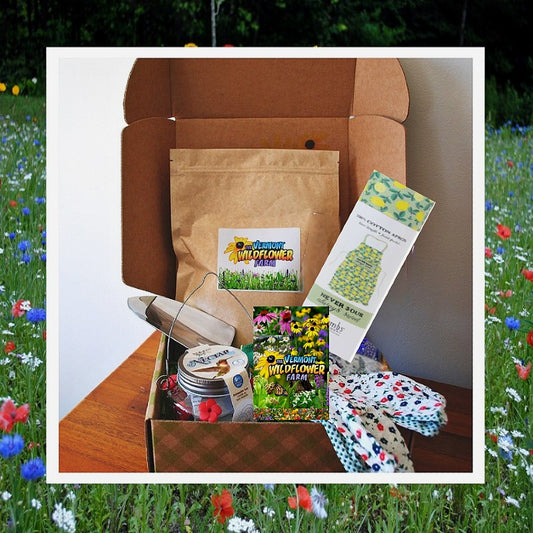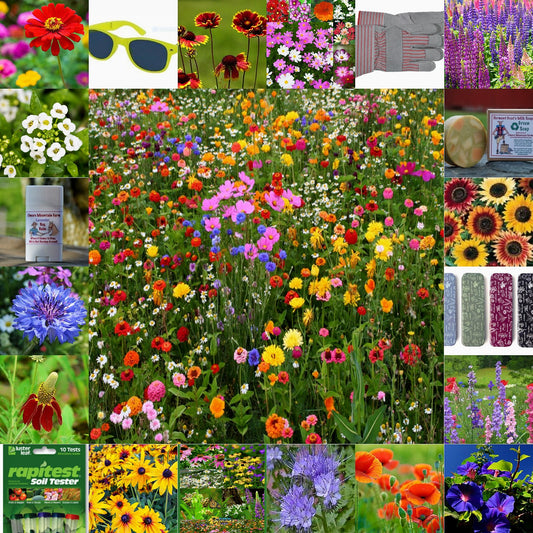Planting Guides | Wildflowers, Natives, Woodland and Trees
The Optimum Wildflower Area Balances Beauty with Durability and Diversity!
Seed Rate Guide oz/1000 sq. ft.
| Type | Rate | Type | Rate |
| B.Breath | 4-oz | Cornflower | 6-oz |
| Poppies | 2-oz | Cosmos | 5-oz |
| Zinnias | 8-oz | Sunflower | 7-oz |
| Daisies | 3-oz | Lupine | 15-oz |
| BESusan | 2-oz | Coreopsis | 6-oz |
| Coneflower | 5-oz | Asters | 1-oz |
| Larkspur | 7-oz | Milkweed | 5-oz |
| Gaillardia | 4-oz | Columbine | 2-oz |
| Seeding | Rates | Avg / Dense | Coverage |
Shipping Schedule
| Type | Shipping Begins |
| Wildflower Seed | Year Round |
| Shipping Time | Within 24-48 hours |
| Custom Seed Mixes | Approx. 1-2 weeks |
We do ship to Alaska & Hawaii by USPS 2nd Day only for bulbs/bareroots. Seed products ship as normal. Before checking out, please e-mail us for a shipping quote if your order contains bulb/plant products.
Bulb & Plant Products Cannot be Shipped to Canada or Any Foreign Country!
Detailed Instructions
In planning a wildflower meadow or garden, first you need to choose your site and estimate the square footage of the area. To find the square footage of any square or rectangular area, simply multiply the length in feet times the width in feet. For example, a border 50 feet long and 10 feet wide is 500 sq. ft. in area (50 X 10 = 500). For a circle, the area is equal to “pi” r squared, or pi (3.1) times the radius of your circle, squared. If your circle is 20 feet across, its radius is half of that or 10 ft. So to get the square footage of the circle: 3.1 X 10 X 10 = 310 sq. ft. The amount of seed you should plant depends on the flower display you want. Most usually want the area to have maximum bloom. All mixtures are pure wildflower seed unless stated that they contain grasses or other types of crops. You can sow a bit on the denser side to help hold out the weeds and grasses. Just be sure not to under or over seed, as under seeding gives a sparser looking area and allows grasses/weeds to work their way in and seeding too densely causes stress as your wildflowers will compete with themselves for space and light making the area generally weaker!
Our suggestion for coverage is as follows:
1 oz. up 100 sq ft
1/4 lb covers 250 - 500 sq ft
1/2 lb covers 500 - 1,000 sq ft
1 lb covers 1,000 - 2,000 sq ft
5 lbs covers 5,000 - 10,000 sq ft
10 lbs covers 10,000 - 20,000 sq ft
50 lbs covers 1+ Acres
SEEDING RATES ARE APPROX. DEPENDING ON THE DENSITY OF COVERAGE YOU DESIRE!
Note: If you have a large site, from ½ acre to several acres, your planting rate may be affected by land conditions. If you have heavy weeds on the site now, some erosion, generally poor soil, or other land problems, additional seed is usually the most economical solution. If your site does have these types of problems and you want to build in some assurance of full coverage, use a per pound coverage rate of 1000 sq ft. We usually suggest 50 lbs. per acre.
Where to Plant: Unless you are planting our Partial Shade Mix or Woodland Species, choose a spot with as much sun as possible. We consider full sun at least 6 hours daily. For wildflowers, full sun is best. Most all soils are acceptable -- if any plant has grown in the spot, it should support wildflowers, which are tough and will adapt to the soil you provide for them.
When to Plant: The optimum time to plant wildflower seed in your area depends on your climate and rainfall patterns, as well as the species you are planting. In cooler climates; plant annuals, perennials or mixtures of annuals and perennials in spring, early summer or late fall. In milder or warm climates; plant wildflower seed during the cooler months of the year, fall through spring. Perennials can be sown spring, summer and fall. If planting perennials late summer be sure to allow 10 weeks growing time before plants go dormant for the winter months. Spring planting: when there is no further chance of a killing frost, meaning that your night time temperatures are maintaining 45 degrees and above. Summer plantings: annuals or mixes containing annuals can be planted through mid-summer. Depending on your climate you want to insure that you have enough time to enjoy all the annuals in your growing season. Perennials can be planted through the summer up until 10 weeks before your cold weather sets in. Fall plantings: in areas with freezing weather, a fall planting must be after a killing frost when your daytime temperatures are maintaining 45 degrees and below but before the ground freezes. In other words, when you are sure cold weather has set in. Killing frosts usually happen at 28 degrees Fahrenheit. Fall plantings in cooler climates are dormant plantings and should be late enough so that the ground temperature is low but the ground is not yet frozen. Seeds must remain dormant – the seeds will germinate in spring. In areas of no frost, plant as your rainy season begins. It is never too late to plant – just ask us for details on how and what to plant!
Soil Preparation: This is the most important step in obtaining success of your wildflower planting, whether it is a small garden or a large meadow. Remove all existing growth, either by hand, rototilling, rough or power raking. Till only deep enough to remove all old roots. Deep tilling may bring up dormant weed seeds lying beneath which will compete with your flowers. If you want to be sure your soil is “weed seed free”, you’ll have to till, wait for the crop of new weeds to grow, usually one to three weeks and then do one of two things; kill them down with one of the safe, non-residual method of using white vinegar; or to till again as in step one. If you use the vinegar method, then once the weeds are dead, lightly rake them out and seed your wildflowers without rototilling or disturbing the soil again. If using the roto-till method, you can seed after the second or third tilling. For those of you that wish to use an herbicide, please read the label for any detrimental effects it may cause. If you choose to use this, use the same steps as if using the vinegar.
About Fertilizer: When you choose to plant wildflowers there is usually minimal weeding done…and fertilizer will encourage the weeds and grasses. Fertilizer is not necessary for a great wildflower garden or meadow. (No one fertilizes in the wild or along roadsides), but if you want this extra boost for your flowers, fertilize only where you are willing to weed.
Sowing: Once your soil is prepared and free of previous growth, it’s important to sow immediately. (If you let time go by between preparation and spreading your seed, you’re giving possible weeds an advantage over your wildflower seed). You can use a hand crank seed spread, but most simply scatter the seed by hand. If you want to be sure to get good, even coverage, divide your seed into two roughly equal parts, in two buckets or cans. Then add clean sandbox sand to both halves, roughly 4-5 parts of sand to 1 part of seed. The sand does two things: It “dilutes” the seed, making it easier to sow evenly, and since it’s light-colored, it shows you “where you’ve been” on the dark soil as you go. Next, sow one bucket’s mix over your whole area. Then go back in the opposite direction and do the same with the second bucket. This way, you should have even spreading and no bare spots. Once seed is sown, do not rake or cover it in any way. If you can, use a lawn roller or lay down a large board and walk on it to compress (squash down) the seed into the bare soil. Remember, some of the seed you’re sowing is tiny; even the lightest covering of soil can stop it from germinating. Keep your new seedbed moist until seedlings are about 6-8” tall. After that, they should be self- sufficient; however, watering during droughts will keep your flowers blooming.
Know your Annuals, Perennials, Biennials: The annuals are quick-growing, quick-blooming and will bloom for months, and then die with a killing frost. Most do reseed, but the seed must fall on bare ground to re-grow the next spring. Perennials are the flowers that “come back every year” from the same roots, forming expanding clumps in your meadow over the years. Perennials may grow and leaf or lie dormant the first year to begin blooming the second and successive years. Biennials bloom the second year and are killed by that year’s frost. However, they are heavy re-seeders, and usually reappear in the meadow. If you are purchasing a mix or annuals and perennials, the annuals will be the ones that give you a first-year color while your perennials establish.
Woodland and Rare Wildflowers - Many seeds of woodland and rare wildflowers have built-in dormancy mechanisms which protect them from germinating before killing frosts or in times of drought. In the wild, seeds will lie dormant until they acclimate to their new environment or until the proper conditions for growth occur. To be successful with these types of species and growing them from seed you must realize that each species has a different method of naturally breaking dormancy. Woodland and Rare wildflowers are not instant garden flowers, and many take a great amount of patience before they germinate and bloom. Once they do, they are well worth the wait.
Maintenance: The amount of work you want to put into your meadow area is up to you. The only requirement is a once-a-year mowing in the fall after killing frosts—to disperse seed and to keep down brushy growth. Another good practice is to identify areas that have become weak or weed-filled, and to reseed those spots, the same way you repair bare spots in a lawn. Once you are able to identify weeds, hand pulling is a viable method of control for the small to medium garden. Any weed that you can pull will constitute to the success of your garden for years. One weed can disperse thousands of seeds, so get ‘em out of there if you can. If you have a large planting and you notice an area of weeds, then the above method of re-tilling and re-seeding that area is your way to obtain maximum success.
Be Patient and Enjoy! Be patient while your garden or meadow establishes but once it has you’ll notice small wildlife, many birds, butterflies and other insects that are attracted to your wild garden; observing these visitors is one of the greatest pleasures of growing wildflowers. Mow paths through your meadow, put in benches and birdfeeders, and enjoy it all for years to come.
Why Plant Native Wildflowers or Grasses? Native plants and grasses require less watering, fertilizer and pesticides. They can prevent water run-off and improve air quality. They preserve biodiversity, repair the earth by restoring native habitats, and increase pollination by providing nectar for pollinators like bees, hummingbirds, butterflies, moths and bats. They also provide protection and shelter for many mammals. The native seeds, fruits, nuts that these plants produce offer essential food for all forms of wildlife. We can't think of one reason you wouldn't want to provide a big or small native meadow or field on your slice of earth!
So, how hard is to do? Whether you have room for a 200 - 500 sq. foot area or acres to create a small or large meadow, it is relatively simple to create a native area, it might just take some initial preparation which will be the most labor-intensive part but is the most important part.
Choose Your Site The next step is to assess the area you wish to plant by seeing exactly what is growing there now. Is it grass, weeds, aggressive or invasive species? Do you have any wildflowers growing there now? Once you have assessed the area, you will have to take steps to remove all existing growth just as you would for any wildflower garden, meadow or field. When choosing a site for native wildflowers, make sure that pollinators have good, clear access to these areas where they will be undisturbed. For example, don't plant next to a noisy area or where you might spray household chemicals, near patios or barbecues etc. Native wildflowers are informal by nature so if you are looking for a more manicured look but want natives, choose upright natives such as Black-eyed Susan, Lupine, Coneflowers, Hyssop, Butterfly Weed and more. You can see a list of native species on our Native Species pages.
I have assessed my area, what now? Check out the soil. Do you have clay, loam, sandy? Is it full of rocks, uneven, or varied? Most native wildflowers will adapt. A smooth area will help but is not necessary. You don't see roadside fields of native wildflowers being smooth or unvaried terrains. Do you best to make larger areas as conducive as possible for seeding. If you have a small area in your backyard, then this area can be smoothed out but for larger meadows or fields, removing the existing growth, leveling as best you can, and soil type will be the most important part. If something is growing there now, wildflowers will grow there as well but a simple soil test that you can purchase from us, or your local hardware store can tell you the pH and organic matter content. Also, while checking your soil, assess whether the soil tends to be wet or dry, is the drainage good or a combination of both and how much light does it get? Native meadows, fields and gardens do best in full sun or partial sun but there are mixes for partial shade and mostly shade too! If you do not have good drainage or you have wet/moist areas, there are native mixes and species for those type of areas too.
Site Preparation You will need to kill off the perennial grasses and weeds first. You can do this by removing the sod or mowing as short as possible and rototilling any top growth beneath the soil. If you have tough rooted plants, tree seedlings, or bushes you should remove those first. Ideally, you will want to try to till as shallowly as possible, just enough to turn over the soil. Till 2-4 inches usually does the trick. Now, you will need to wait until growth pops up. You will need to remove this growth again by rototilling again and waiting to see what pops up and remove it, do not rototill again after the area is clear of undesirable plants or grasses, just pull by hand. You can also cover the area if small enough with clear plastic sheeting. This is called solarization which diminishes the viability of any dormant weed seeds.
Once you have determined the area is weed free, you are ready to seed.
Seeding in Spring? Choose your native wildflower seed mix. species and native grasses if you wish to add them! Since native wildflowers or grasses can take a season or two to establish if you are planting in spring, we do suggest adding a companion crop of annuals.
Seeding in Fall? If you are seeding a native mix in fall, you can just seed the native mix and you do not necessarily need a companion mix of annual wildflowers. For spring
planting, wait until after all chance of frost has passed and if you are seeding in fall, wait until you have had a couple of hard frosts, when you are sure cold weather has set in. For both times of seeding, once your soil is prepared and free of previous growth, it's important to sow immediately. (If you let time go by between preparation and spreading your seed, you're giving possible weeds an advantage over your wildflower seed). You can use a hand crank seeder, an over the shoulder seeder etc., but most folks simply scatter the seed by hand. If you want to be sure to get good, even coverage, divide your seed into two roughly equal parts, in two buckets or cans. Then add clean sandbox sand to both halves, roughly 4-5 parts of sand to 1 part of seed. The sand does two things: It dilutes" the seed, making it easier to sow evenly, and since it's light-colored, it shows you "where you've been" on the dark soil as you go. Next, sow one bucket's mix over your whole area. Then go back in the opposite direction and do the same with the second bucket. This way, you should have even spread and no bare spots. Once the seed is sown, do not rake or cover it in any way. If you can, use a lawn roller or lay down a large board and walk on it to compress (squash down) the seed into the bare soil. Remember, some of the seed you're sowing is tiny; even the lightest covering of soil can stop it from germinating. Keep your new seedbed moist until seedlings are about 6-8" tall. After that, they should be self- sufficient; however, watering during droughts will keep your flowers blooming. If you have used an annual companion mix, those should be up the first year! If sowing in fall, you will have some growth and bloom from native perennials the following spring with the full potential of the native meadow, garden or field the following year. Natives, like most perennials, need a period or two of cold.
Maintenance of your Native Meadow, Garden or Field - Most native fields or meadows do not need much maintenance. You can take some or all the following steps if you wish. The amount of work you want to put into your meadow area is up to you. A once-a-year mowing in the fall after killing frosts may be beneficial; to disperse seed and to keep down brushy growth. Another good practice is to identify areas that have become weak or weed-filled, and to reseed those spots, the same way you repair bare spots in a lawn. Once you are able to identify weeds, hand pulling is a viable method of control for the small to medium garden. Any weed that you can pull will constitute the success of your garden for years. One weed can disperse thousands of seeds, so get them out of there if you can. If you have a large planting and you notice an area of weeds, then the above method of re-tilling and re-seeding that area is your way to obtain maximum success. If you choose not to mow down your native area leaving the seed heads for wildlife, it is still beneficial to assess any area of weeds.
Woodland and Rare Wildflowers
Woodland and Rare Wildflowers
About: Many seeds of woodland and rare wildflowers have built-in dormancy mechanisms which protect them from germinating before killing frosts or in times of drought. In the wild, seeds will lie dormant until they acclimate to their new environment or until the proper conditions for growth occur. To be successful with these types of species and growing them from seeds you must realize that each species has a different method of naturally breaking dormancy. Woodland and Rare wildflowers are not instant garden flowers, and many take a great amount of patience before they germinate and bloom. Once they do, they are well worth the wait.
Different Ways Woodland and Rare Species Break Dormancy: Each species is different. Some are relatively quick and act like traditional perennials while others can take a few years. Below, we have outlined different ways these species break dormancy to help you better understand why some take longer than others. It will also help you to better understand why they don't germinate the first or second year - so don't give up on them!
G1. - Some species germinate upon sowing in a warm location like any other perennial. They grow and leaf the first year to begin blooming the second and successive years.
G2. – These species need a cold, moist stratification i.e.. Fall/Winter.
G3. - Very small seeds need light to break dormancy so they should be planted no deeper than 1/8th of an inch and just a light layer of soil cover. They shouldn't be allowed to dry out. You can tell the size of your seeds by just looking at them. These species need one period of cold stratification
G4. - These species will need a warm, moist period followed by a cold, moist period and will need 2-4 full years of these alternating conditions to break dormancy.
Planting Information: Seeds needing scarification, nicking or any specialized treatments with the exception of stratification have been done before shipping to you. Select a planting location with partial shade or shade or filtered light. Prepare the planting bed so that the soil is well draining and rich in humus. The best way to do this is to till the top few inches of soil with a garden rake and then mix in several inches of humus, such as compost or peat moss if the soil is not already rich and well-draining. Plant the seed 1-2 to 1 inch below the surface of the soil unless you have small seeds which should be planted no deeper than 1/8 inch. Cover with a light layer of soil. Most seeds need to be protected from drying winds and sunlight so cover them quickly. Water well if planting in spring, water lightly if planting in fall.
Fern Spores: Direct sow fern spores on soil surface and pat them down for a good spore to soil contact.
About Stratification of Native and Woodland Species:
Most woodland and native wildflowers need cold stratification before germinating. Some species will need more than one period of cold stratification.
We do suggest planting these types of species where you wish them to grow and let nature take its course vs. trying to replicate the stratification process.
If you wish to try and replicate this process, put the seeds in a sterile media such as a paper towel, sand or vermiculite that is slightly moist but not wet (be careful that there is not too much moisture/water) and place the seeds in a plastic Ziplock bag and close tightly. Place the bag in the fridge for 60 days and then do 1 of 2 things:
1) Sow your seedlings where you wish them to grow. This only occurs if you need just one period of cold stratification.
2) If a species needs more than one period: after the 60-day period of cold, place the bag in a dark warm place for 30-45 days and then repeat the cold/warm period/s as needed until you see sprouts. If they germinate in the bag, they should be sown immediately.
Woodland and native wildflowers should not be planted in pots or seed trays before stratifying them.
Woodland and native wildflowers take time to establish. These are not first year blooming species.
Periods of Stratification:
G1 – acts like a traditional perennial – see Germ Code 1 above.
G2 – one period of cold stratification
G3 – one period of cold stratification
G4 - multiple periods of cold stratification
Any Question - Contact Us
Elderberry Seeds – Germ Code 2- The best time to plant Elderberry Seeds is in fall or early winter. They can be planted in spring or summer during warmth but will take longer to germinate. You should choose an area that will allow for larger growth bushes, trees or shrubs. They should not be crowded, and they should get at least 4-6 hours of sunlight for proper flowering and berry production. Soil should be loamy. Adjust your soil if you need to. It should be moist but well drained. Plant the seed approx. ¼ inch deep and cover with a light layer of soil. Water enough so that the top 2 inches of the soil is moist. Keep soil moist through any warm periods and then water only when the soil dries out until spring. In hotter months keep the soil moist. Elderberries need a few periods of stratification before germinating so be patient!
Flowering Dogwood Seeds – Germ Code 4 – Plant Flowering Dogwood seeds after soaking in water for approx. 4-6 hours and after all chance of frost has passed in spring. These will need periods of stratification before breaking dormancy i.e., warm, cold, warm etc. Plant in a location of Partial Shade to Shade but the area should get some sun during the day. The soil should be moist but not wet and the area should be kept moist but never soaked for any length of time as the seeds will rot. Spread the seeds out over the top of the soil and cover with a light layer of soil and tamp down.
Winterberry Seeds – Germ Code 4 - Winterberry is fairly easy to grow but will need periods of stratification to break dormancy. Plant in an area with some sun to partial shade which is undisturbed in slightly acidic soil. Spread the seeds out over the top of the soil for a good seed to soil contact. Winterberries are not picky about soil type or moisture – wet, moist but if the soil becomes dry, it will need watering.
Witch Hazel Seeds – Germ Code 2 - Witch hazel is easy to grow but will need about 1-2 years and periods of warm, cold, warm to germinate. Plant in a bright location in slightly acidic soil in an area with good moisture retention but well-draining. They are fairly maintenance free but benefit from a good pruning each year. Please seed just under the soil. You can do this by placing the seed on top of the soil and pushing slightly below and tamping down. Be sure to water it during the hotter months.
Spicebush Seeds – Germ Code 1 - Spicebush is easy to grow, should sprout the following year after seeding. Planting in an area of partial shade in rich, moist soil is best. Plant the seed pointed side up under approx. 1/8 inch of soil.
NOTE: as with all tree seeds, plant more than you wish to grow. You can thin out any extras that germinate. Some tree species will need both male and female seeds so planting more than necessary is an important step. All tree seeds need patience!
GERM CODES:
G1. - Some species germinate upon sowing in a warm location like any other perennial. They grow and leaf the first year to begin blooming the second and successive years.
G2. - Some species need a cold, moist stratification followed by an extended cold period ie. Fall/Winter.
G3. - Very small seeds need light to break dormancy so they should be planted no deeper than 1/8th of an inch and just a light layer of soil cover. They shouldn't be allowed to dry out. You can tell the size of your seeds by just looking at them.
G4. Some species will need a warm, moist period followed by a cold, moist period and will need 2-4 full years of these alternating conditions to break dormancy.
Common Questions
Seeding rate varies according to species and mixes. Average seeding rate is 1 lb. covers 1,000 to 2,000 sq. ft.
You can plant Spring, Summer or Fall. In order to take advantage of the entire growing season, most gardeners do a double seeding (half in fall and half in spring). On average, fall planted seeds germinate a few weeks sooner than spring planted seeds.
Most spring seed annuals and fall seed perennials but you can do both at either time.
Once danger of frost is gone and nighttime temperatures are above 45 degrees.
Usually, 12 weeks prior to first frost
Usually, 8 weeks prior to killing frost.
Northern states: after a couple killing frost (28 degrees or below) – usually between November and January.
Southern states: Once your rainy season begins.
Contact Us for Suggestions!
All wildflowers are beneficial, but we recommend our Deluxe Pollinator Mix, Native Perennial Pollinator Mix, Native Perennial Pollinator & Grass Mix, Hummingbird Butterfly Mix, Honeybee Mix, or Honeybee Feed & Forage Mix. These mixes have everything for everybody!
The technical answer is no, all wildflowers need some sort of light. There is one wildflower that will do well in complete shade, Forget-me-not and you can also use our Woodland or Hand Gathered and Rare species. Call or e-mail us for advice.
Annuals produce a flower the first growing season, are usually bright and colorful, and die off at the end of the season but most reseed themselves.Perennials don’t produce a flower until the second or third growing season but keep coming back year after year from the same plant and also reseed themselves.
We usually recommend a once year cutting or mowing at the end of growing season (once the bloom ends). Most do a light overseeding with half or a quarter of the amount initially seeded in order to bring back the annuals and boost up the perennials or simply to customize the wildflower garden with their favorite species or mixes. Others, prefer to do a one-time dense seeding so they don’t have to do anything at all but sit back, relax, and enjoy nature at its best!
You can store your seeds in a cool/dry/dark place such as basement, garage, or pantry.
Technically, no - but some may need to add lime, fertilizer, gypsum or other additives. (Contact us for details)
Once germination happens, keep moist until seedlings are 6-8” tall - you may need to water every other day unless Mother Nature is providing the rain.
Most wildflowers do not like transplanting - so plant your seeds where you want to see them grow!
Use our Plant, Weed and Bloom identification page under Resources.
We do! You can find a guide to Early, Mid and Later Season bloom and seeding rates on our Resources page.
We do! To see what your neighbors are doing, go to Resouces to find the customer gallery.
NO, absolutely not. We do not sell invasive species. The Queen Anne’s Lace we sell is the annual, (Ammi majus) and not the invasive, Daucus Caroata.
Yes, mix and match away! You can also mix mixes together or add additional species - the creativity is endless!
Store seeds in a cool and dry place. If stored properly seeds are viable for years!
Some only believe in a Spring seeding while others only believe in a Fall Seeding. We seed Spring, Summer and Fall in order to take advantage of the entire growing season!
Yes, we ship when you want to - just let us know when - we’re at your service!
Most orders ship within 2 business days. Exceptions may apply such as during the spring/fall planting rush or pending laboratory germination testing results. Of course, advance sale items ship according to the information listed on the product page such as flower bulbs and bareroot plants.
We usually ship via US Mail and yes, we do ship to a PO Box as it’s secure and dry.
For UPS shipments: please email support@vermontwildflowerfarm for shipping charges and delivery date.
Feel free to use the ‘Comments Field’ at checkout.
Here are some examples:
“Please waive signature”
“Please leave package by front door”
“We’ll be out of town next week. Please ship after our return”
“Please ship order in full in the spring”
“Please ship order in full in the fall”
Items You May Need
-
Weekend with the Kids Garden Box
We have created this kid's garden box so you can have a great time on the weekends with your kids in the garden. Read MorePrice: $69.95Price:Unit price / per$99.90Sale price $69.95 -
Pet Friendly Garden Box
Our pet friendly garden box contains our Pet Friendly Wildflower seed mix, accessories and some fun things for your dog and cat! Read MorePrice: As Low As: $69.95Price:Unit price / per$99.90Sale price As Low As: $69.95 -
Homeowners Garden Box
A great gift for a new homeowner, neighbors, friends and family! Read MorePrice: $99.95Price:Unit price / per$118.50Sale price $99.95 -
Go Wild Wildflower Seed Kit
A beautiful box full of blooms & garden supplies. Read MorePrice: $99.95Price:Unit price / per$149.20Sale price $99.95
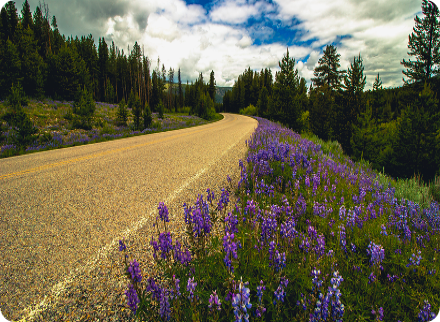
We offer CUSTOM Seed Mixes for All Your Projects!
We've got you COVERED for Landscape
Management, Conservation & More!
